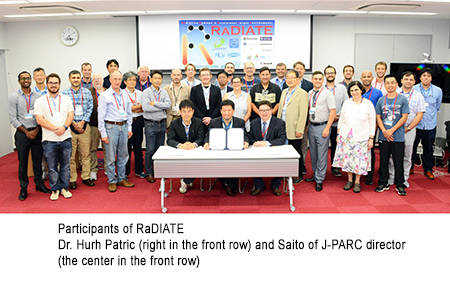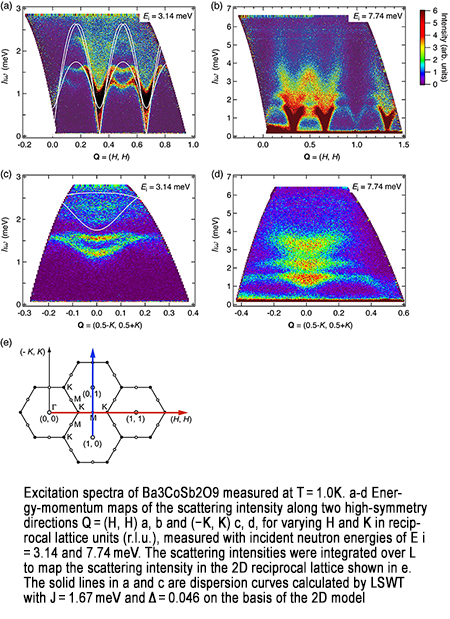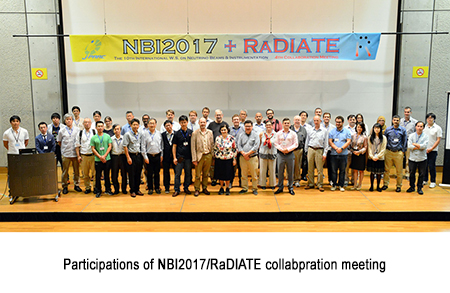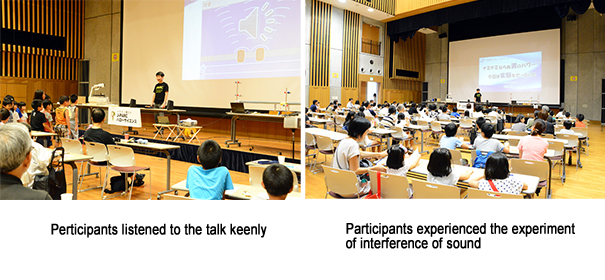| ‘ J-PARC News - September 2017 (Issue #149) |
| Signing ceremony of the memorandum of understanding with RaDIATE for participation in international joint research projects (September 20, J-PARC) |
|---|
| For 3 days from September 20, the 4th collaboration meeting of RaDIATE (Radiation Damage In Accelerator Target Environments) was held at Tokai-village. RaDIATE provides a system to promote international collaboration for cooperative research on radiation damage from a high-energy proton accelerator in target and window materials. During the meeting, on September 20 J-PARC Center director Naohito Saito signed a memorandum of understanding for J-PARC participation, under the attendance of Dr. Hurh Patric at J-PARC. Dr. Patric is from the Fermi National Accelerator Laboratory (FNAL) of the US, who manages the collaboration of research programs. RaDIATE collaboration started in 2013 with five European and American organizations. Today, 11 organizations participate and form the international cooperation system. Since 2016, J-PARC had requested to join the collaboration because it saw the advantage of gaining knowledge that would allow long-term stable operation of the facility, such as improved functionality of targets for secondary particle production and beam windows for experiments at J-PARC. The request was granted, and this occasion had taken place. |
| |

 * Click here to enlarge. * Click here to enlarge. |
| £to Page Top |
|
| The correlation of hydration state and molecule structure factors of biocompatible polymer materials revealed (August 29, press release) - A prospect for an innovative improvement to medical polymer material's performance - |
|---|
| A research group lead by professor Atsushi Takahara and assistant professor Yuji Higaki of Kyushu University Department of the Fundamental Organic Chemistry / International Institute for Carbon-Neutral Energy Research had a collaborative research project with Dr. Yuka Ikemoto and Dr. Taro Moriwaki of the Japan Synchrotron Radiation Research Center (JASRI) and assistant professor Norifumi Yamada from the High energy Accelerator Research Organization (KEK) (J-PARC Neutron Instrumentation Section), etc. The collaborative research group elucidated the nanostructure of zwitterionic polymers in aqueous solutions, using infrared spectrometry at a large synchrotron radiation facility (SPring-8) and neutron reflectometry* at the Material and Life Science Experimental Facility (MLF). Zwitterionic polymers mimic the structure of biological molecules and have a high biocompatibility. For this reason, it is expected to be the future-generation of high performance biomaterial. From this finding, the biocompatibility expression mechanism was understood. This study was published in the scientific journal of the American Chemistry Society (ACS), "Langmuir", as ACS Editor's Choice article in August 17, 2017. Also, this study was funded by the Photon and Quantum Basic Research Coordinated Development Program of the Ministry of Education, Culture, Sports Science and Technology and conducted as joint research of JASRI and KEK. |
| * BL 16: the neutron reflectometer measuring instrument "SOFIA" |
| |

 * Click here to enlarge. * Click here to enlarge. |
| £to Page Top |
| |
|
| The whole picture of unique magnetic excitations that arise from the synergy between frustration and quantum effects was observed by neutron scattering (September 8, press conference) - Presented the guidelines for a new theory of magnetism - |
|---|
| The research group, which consisted of Saya Ito, a graduate student from the Tokyo Institute of Technology (currently at Chiyoda Corporation), assistant professor Nobuyuki Kurita, professor Hidekazu Tanaka, senior principal researcher Kenji Nakajima from the Japan Atomic Energy Agency (J-PARC Neutron Science section leader), assistant principal researcher Seiko Kawamura (J-PARC Neutron Science section), professor Shinichi Itoh from KEK (J-PARC Neutron Science section), etc., focused on "Ba3CoSb2O9 (barium cobalt antimony oxide)" which is an optimal model substance for triangular-lattice Heisenberg antiferromagnets. The group created a large single crystal sample and used neutron scattering to discover the details of unique magnetic excitations, which were significantly different from ones seen in regular magnetic substances. This study was published in the online version of the scientific journal from the United Kingdom "Nature Communications" dated August 10. |
| * BL14Fthe cold-neutron disk chopper spectrometer "AMATERAS" |
| |

 * Click here to enlarge. * Click here to enlarge. |
| |
| £to Page Top |
| |
|
| 10th International Workshop NBI2017/4th RaDIATE Collaboration Meeting (September 18-22, Tokai-village Industry and Information Plaza "iVil") |
|---|
| From September 18 to 22, J-PARC Center held the 10th International Workshop NBI2017/4th RaDIATE collaboration meeting at "iVil" in Tokai village. In 1999, the High Energy Accelerator Research Organization (KEK) held the first NBI (International Workshop on Neutrino Beams and Instrumentation) with the European Organization for Nuclear Research (CERN) and the United States Fermi National Accelerator Laboratory (FNAL). Both are making progress on neutrino oscillation experiments. Ever since, each country continues to hold the meeting in turn, and exchanges information such as issues, solutions and more on neutrino research. In addition, the secondary particle production target and its container, proton beam window, etc. will need to support stronger accelerator output power down the road. Because this matter is closely associated with the international meeting of the RaDIATE (Radiation Damage In Accelerator Target Environments) international collaboration of cooperative research, both meetings were jointly held at the Tokai-village this time. The meeting offered over 70 seminars, including 7 which had representatives from research organizations in England, the US, and other countries connected via the Internet. And, seminar participants had valuable discussions. In addition, on tours offered at related facilities, participants and persons in charge at each facility engaged in active Q&A discussions. |
| |

 * Click here to enlarge. * Click here to enlarge. |
| |
| £to Page Top |
| |
|
| Separate nuclear wastes to recycle in nuclear reactor with accelerator: group partitioning and nuclear transmutation technology utilizing ADS |
|---|
| The exhibition is currently open (August 1 - December 21(tentative), Joho Hiroba of the Ministry of Education, Culture, Sports Science and Technology (MEXT)) For 5 months from August1, The Japan Atomic Energy Agency (JAEA) is holding an exhibition on nuclear wastes reduction with Accelerator Driven Systems (ADS), on which J-PARC conducts R&D, at Joho Hiroba of MEXT (inside the former MEXT building). Nuclear wastes generated by nuclear power plants can also be disposed of much easier if it is separated like regular garbage and processed by ADS. The exhibition explains in plain terms about nuclear transmutation technology utilizing ADS, an application of the world's most advanced accelerator technology in J-PARC. So, please have a look at the exhibition. |
| |

 * Click here to enlarge. * Click here to enlarge. |
| |
| £to Page Top |
| |
|
| 8th J-PARC Hello Science "Naminaminaranu wave power ~ Let's do lots of experiments today!~" (August 25, Tokai-village Industry and Information Plaza "iVil") |
|---|
| Every last Friday of the month, we hold a Science Cafe "J-PARC Hello Science", aiming for J-PARC to meet with the locals. In July and August, it was pushed forward and held during the day, accommodating children on summer break. This August, we took "waves" as our theme and demonstrated many experiments. We used water, sound and light, as "waves" around us for the experiments, and explained that cutting edge research like neutrinos at J-PARC was fully utilizing the power of "waves". For an experiment on interference of sound, we used two speakers. One by one, participants experienced that sound coming from the speakers was audible and not audible depending on where they stood. Like the last time during "Hello Science", many families visited us. We had over 100 participants. |
| |
 |
| |
| £to Page Top |
| |
|
| On the experiment facilities (summer maintenance) |
|---|
| (1) Completed the beam dump in a high-p beam line at the Hadron Experimental Facility. (September) |
| (2) Replaced the proton beam window of the target station in the Neutrino Experimental Facility. (August 22-23). |
| (3) Completed and delivered the mercury target vessel of the Material and Life Science Experimental Facility (MLF). (September 22) |
| |

 * Click here to enlarge. * Click here to enlarge. |
| £to Page Top |
| |
|
©2017 J-PARC Center. All rights reserved.
|
|